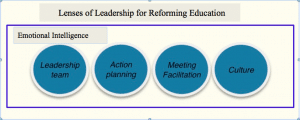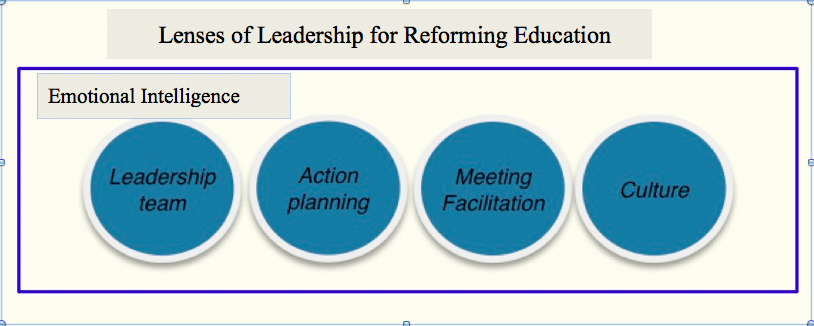Leadership in a Competency-Based System
CompetencyWorks Blog
 At what point did leading a school through a continuous improvement process become so confusing? In my educational leadership classes, I spent a great deal of time focusing on what leadership is and developing a philosophy that would guide me. I thought I had it all figured out. I learned the difference between first order and second order change. I was told to have a vision, communicate it regularly, and work to make it a reality. I also needed to remember that I would be leading people and not machines. They will no longer respond to top-down dictates. If you want to make lasting change to improve education, you must include people in the conversation so they can weigh-in before they buy-in. Okay. Simple. I earned an ‘A’, completed my master’s degree, and felt ready to change the world!
At what point did leading a school through a continuous improvement process become so confusing? In my educational leadership classes, I spent a great deal of time focusing on what leadership is and developing a philosophy that would guide me. I thought I had it all figured out. I learned the difference between first order and second order change. I was told to have a vision, communicate it regularly, and work to make it a reality. I also needed to remember that I would be leading people and not machines. They will no longer respond to top-down dictates. If you want to make lasting change to improve education, you must include people in the conversation so they can weigh-in before they buy-in. Okay. Simple. I earned an ‘A’, completed my master’s degree, and felt ready to change the world!
Then I became a building leader, and suddenly someone had put a giant slab of granite in front of me, and I could not see a path forward. I shared my vision, but people pushed back. No matter how hard I tried to communicate, they became more confused, overwhelmed, and exhausted. Even those initially excited about the reforms became skeptical of their possibilities. I was at a loss.
I began to read more and more from leaders and business consultants on how to become a better leader. The words of Bob Sutton, Dan Heath, Lee Cockerell, and John Wooden, amongst others, allowed me to begin forming theories of how I could lead my colleagues. A big breakthrough came when my district chose to partner with the Reinventing Schools Coalition who entered with the “tools” to drive change. Now I had the why, the how, and the tools to do it.
The role of a principal is multifaceted. They are to be the instructional leader while also managing the day-to-day operations of a learning community. In my work leading change in schools, I have realized the importance of keeping the managerial tasks and the leadership responsibilities separate. To help me do this, I established the following group of “lenses” my practices must pass through to help focus my efforts on the end vision while allowing me to see the critical moves I need to make. It is not about having a specific strategy, but about having an effective strategy that works for me and passes through the lens.
I offer my thoughts here for the purpose of using this virtual room to build a deeper and better understanding of how to lead change in schools. Moving from the theoretical and philosophical to the practical is important for the modern school leader.
The visual model I use has four lenses that need to be aligned so when I make a decision I am sure it passes through to continuously focus me on the work of leading reform. The lenses are (1) Building a Leadership Team, (2) Action Planning, (3) Meeting Facilitation, and (4) Culture. This is all done while being embedded in what Daniel Goleman calls emotional intelligence. If the people you lead are not with you, you are not truly leading. What follows are brief descriptions of the lenses. I will provide further details of each lens in subsequent posts.
Lens 1: Building a Leadership Team. This is about giving people control over their work. I believe my job is not to be the most powerful person in the room, but to grow the organization by empowering others to develop leadership skills within themselves. (Authors: Patrick Lencioni, Lee Cockerell, Michael Fullan, Andy Hargreaves.)
Lens 2: Action Planning. Once I understood strategic planning to be one of my roles, I was able to move forward in supporting my colleagues in a way that did not overwhelm them. This is about moving from our reality closer to our vision, using data to inform and script our critical moves. A well-defined action plan tells people within the organization what we need to attend to, measure, and revisit so we do not get into the habit of hitting with a “drive-by” professional development and considering it done. (Authors: Bob Sutton, Dan Heath, Steven Kramer)
Lens 3: Meeting Facilitation. I was never given strategies to run effective meetings, and yet it is critical to what we do as leaders. In times of stress, humans retreat to what they know. Leaders default to meeting structures they know even if they are ineffective. Typically we treat all meetings the same, when, in reality, they should have different structures for different purposes. (Authors: Patrick Lencioni, Simon Sinek)
Lens 4: Culture. This is not part of the game. This is the game. You get what you create and what you allow. We cannot blame the teachers, staff, or students for how the school looks and feels. If we do not address it, we own it. The culture needs to include a growth-mindset and an innovative spirit. All stakeholders should be included and know of your commitment to continuously improve the process. (Authors: Henry Cloud, William Dufris, Gary Hamel, Daniel Pink, Carol Dweck)
When reflecting on the decisions I make throughout the day, I use the lenses to make sure I am focused on leading the building to our vision. I also use the lenses to set priorities for what I need to better understand, support, or create to move us to a student-centered, proficiency-based learning school. By having the lenses, I am focused but not locked into a “has to be done this way” approach. The simplicity of having four lenses versus 50 strategies allows me to share with other leaders in my building how we will approach our work together.
But it is not perfect. I am constantly seeking other views and thoughts so I can continuously approach my role as leader. I ask for your thoughts and considerations.
